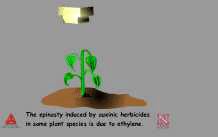Chapter 17: MOA Part 3: Growth Regulators (Auxinic Herbicides)
17.4 Injury Symptoms
The growth and anatomy symptoms induced in plant species sensitive to auxinic herbicides are similar to those induced by high doses of the natural hormone, IAA. After exposure to a high dose, symptoms include cupping and stunting of leaves, brittleness, stunting and twisting of stems, and general abnormal growth of susceptible species. Terminal leaf growth ceases. Tissue proliferation along the stem takes place first at the stem tip, then the nodes and finally along the length of the stem resulting in disintegration or blockage of phloem and xylem tissue. Meanwhile, epinasty and bending and splitting of the stem occurs.
Roots become thickened and stunted. Adventitious roots or callus tissues develop which crush the phloem and cortex, eventually resulting in rupturing of the epidermis of stem tissues. Symptoms normally appear within a few hours or days, although death may not occur for several weeks or months.
This animation illustrates which processes change in a plant cell in response to auxin and how these changes may be involved in plant injury. Once the auxinic herbicide gets into the plant and reaches a living cell, auxinic herbicides are thought to bind to a receptor. This is the same receptor that recognizes the natural hormone, IAA, and this binding acts as a signal for the cell to turn on several genes. The signal that the auxin is present causes a cascade of secondary responses or messages, which tell certain genes to turn on. The animation shows several genes being turned on by auxins; some have a known function and others do not. A classic response to auxins is cell elongation. In this example, auxins actually induce a gene that helps loosen the cell-wall region. This loosening causes differential lengthening on one side of a stem compared to another, resulting in the characteristic twisting, known as epinasty.
*The animation requires Flash player to work.

Grass crops are tolerant to auxinic herbicides, but may be injured if these herbicides are applied during rapid cell division (tillering, flowering) or during rapid growth (high temperatures and high soil moisture). Corn and sorghum stems may become brittle after auxinic herbicide application. Wheat and rice may exhibit buggy-whipped, malformed seed heads after 2,4-D application.
Broadleaf crops such as cotton and grapes are especially sensitive to drift from 2,4-D, 2,4-DB, and triclopyr when used in nearby fields. Cotton leaves will be narrow and crinkled (okra-leafed) and bolls may have a beaked appearance. Cotton will grow out of the injury if the concentration in drift is low. If the drift concentration is high, cotton maturity will be delayed and yield will be reduced. Soybeans, peanuts, and alfalfa are tolerant to 2,4-DB because they do not convert it to 2,4-D as susceptible plants do. However, susceptible soybeans may display crinkled, wavy leaves (strapped) after 2,4-DB applications, but will grow out of this condition.
An extension article from Iowa State University summarizes research on soybean sensitivity to 2, 4-D and Dicamba. The results show that soybeans are far more sensitive to dicamba than 2,4-D. https://crops.extension.iastate.edu/soybean-response-sublethal-doses-24-d-and-dicamba
In the next section, we will discuss new crop variety options that have resistance to these herbicides.
Review and Reflection